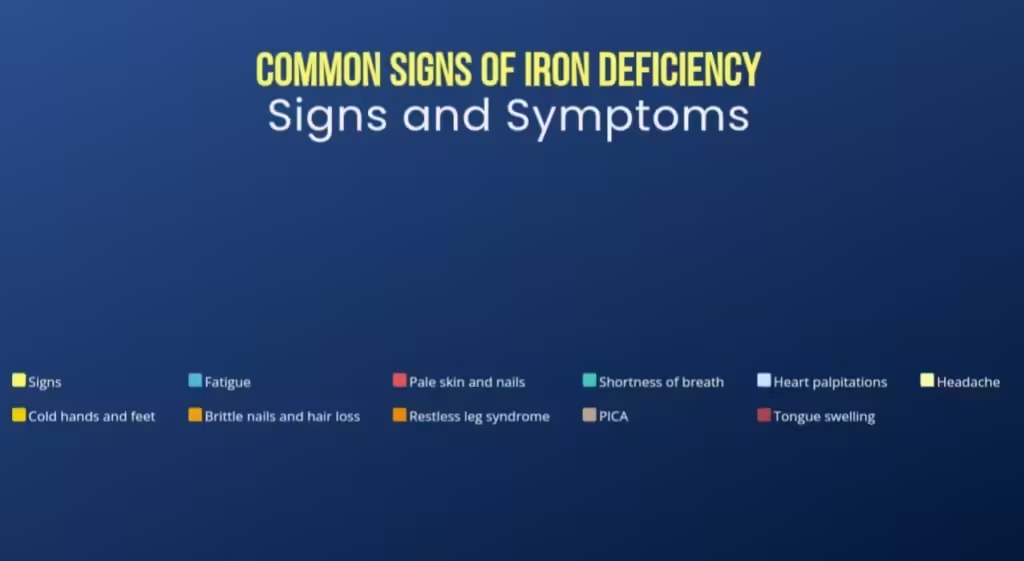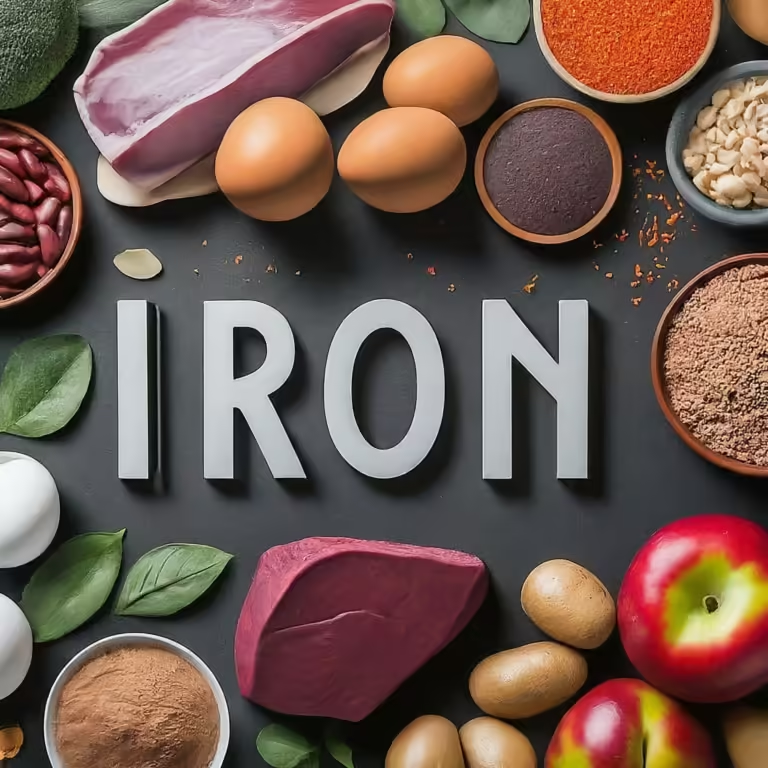Medically reviewed by Dr Itender Pal Singh
Iron deficiency is one of the most common nutritional deficiencies worldwide, it’s best to be educated about signs of iron deficiency. It affects millions of people, especially women and children. Iron plays a crucial role in producing haemoglobin, a protein in red blood cells responsible for carrying oxygen throughout the body. Without adequate iron, the body can’t produce enough healthy red blood cells, leading to a range of health issues. Here, we’ll discuss in details with easy language, the common signs of iron deficiency and what you can do to prevent or treat it. But first let’s discuss other details about Iron before discussing signs of Iron deficiency.
In this article-
Role of Iron in the Body: Functions and Importance
Iron is an essential mineral that plays a crucial role in various bodily functions. It’s a key component of haemoglobin, the protein in red blood cells that carries oxygen from the lungs to the rest of the body. However, iron’s importance extends far beyond this primary function. In this section, we’ll explore the uses of iron in the body, the types of dietary iron, and the importance of maintaining adequate iron levels.
1. Oxygen Transportation
The Role of Haemoglobin:
Iron is a fundamental part of haemoglobin, the molecule in red blood cells that binds to oxygen. Haemoglobin allows red blood cells to carry oxygen from the lungs to tissues and organs throughout the body. Without sufficient iron, the body cannot produce enough healthy haemoglobin, leading to reduced oxygen supply and the associated symptoms of fatigue, weakness, and anaemia.
Myoglobin and Muscle Function:
In addition to haemoglobin, iron is also a component of myoglobin, a protein that provides oxygen to muscles. This oxygen is crucial for muscle contraction and overall muscle health. Low iron levels can impair physical performance and cause muscle fatigue.
2. Energy Production
Cellular Energy Metabolism:
Iron is vital for the body’s energy production processes. It is involved in the synthesis of adenosine triphosphate (ATP), the primary energy carrier in cells. Iron-containing enzymes participate in the electron transport chain, a series of reactions in the mitochondria that generate energy. Insufficient iron can disrupt this process, leading to lower energy levels and feelings of tiredness.
3. Immune System Support
Boosting Immunity:
Iron plays a critical role in the immune system. It supports the proliferation and maturation of immune cells, particularly lymphocytes, which are essential for fighting off infections. Iron is also involved in the production of reactive oxygen species (ROS) used by immune cells to kill pathogens. A deficiency in iron can weaken the immune response, making the body more susceptible to infections.
4. Cognitive Function and Brain Health
Iron and Neurotransmitter Production:
Iron is necessary for the synthesis of neurotransmitters like dopamine, norepinephrine, and serotonin, which regulate mood, behaviour, and cognitive function. Adequate iron levels are essential for maintaining mental clarity, focus, and overall brain health.
Impact on Cognitive Development:
In children, iron deficiency can impair cognitive development and learning abilities. Iron is crucial during periods of rapid growth and brain development, and a lack of it can lead to developmental delays and behavioural issues.
5. Hormonal Regulation
Thyroid Function:
Iron is a key component of enzymes involved in the production of thyroid hormones, which regulate metabolism. Thyroid hormones influence nearly every metabolic process in the body, including growth, development, and energy expenditure. Iron deficiency can lead to hypothyroidism, a condition where the thyroid gland doesn’t produce enough hormones, resulting in weight gain, fatigue, and other metabolic issues.
6. Detoxification and Liver Function
Iron in Detoxification:
The liver relies on iron-containing enzymes, such as cytochromes, to break down and eliminate toxins from the body. These enzymes are involved in the metabolism of drugs, alcohol, and other harmful substances, aiding in the detoxification process.
Supporting Liver Health:
Adequate iron levels are essential for maintaining liver health and ensuring that the liver can effectively process and remove toxins. However, too much iron can be harmful, leading to conditions like haemochromatosis, where excess iron accumulates in the liver and other organs.
Types of Dietary Iron: Heme vs. Non-Heme Iron
1. Heme Iron:
Heme iron is found in animal-based foods and is the most efficiently absorbed form of iron. It is present in red meat, poultry, and fish. The body absorbs heme iron at a higher rate than non-heme iron, making it a more reliable source for maintaining iron levels.
2. Non-Heme Iron:
Non-heme iron is found in plant-based foods, such as beans, lentils, spinach, and fortified cereals. While non-heme iron is less readily absorbed by the body compared to heme iron, its absorption can be enhanced by consuming it with vitamin C-rich foods, like citrus fruits, tomatoes, and bell peppers.
Maintaining Adequate Iron Levels:

Dietary Sources of Iron:
Incorporating a balanced diet that includes both heme and non-heme iron sources is essential for maintaining adequate iron levels. Foods rich in iron include:
- Red meat, poultry, and fish (heme iron)
- Beans, lentils, and tofu (non-heme iron)
- Spinach, kale, and other leafy greens (non-heme iron)
- Nuts and seeds (non-heme iron)
- Fortified cereals and grains (non-heme iron)
Iron Supplements:
In some cases, dietary intake alone may not be enough to meet iron needs, especially in individuals with increased requirements, such as pregnant women or those with chronic conditions. Iron supplements can help restore and maintain adequate iron levels. However, it’s important to consult a healthcare provider before starting any supplement regimen, as excessive iron intake can be harmful.
Risks of Excessive Iron:
While iron is essential for health, too much iron can be toxic. Conditions like haemochromatosis, where the body absorbs and stores too much iron, can lead to liver damage, heart problems, and other serious health issues. It’s crucial to balance iron intake and avoid self-prescribing iron supplements without medical guidance.
Commons signs of Iron Deficiency

1. Fatigue and Weakness
Among signs of iron deficiency, first one is Fatigue. Fatigue is often the first noticeable sign of iron deficiency. When your body lacks iron, it can’t produce enough haemoglobin, resulting in less oxygen reaching your tissues and muscles. This lack of oxygen makes you feel tired and weak, even after a full night’s sleep.
If you experience persistent fatigue that doesn’t improve with rest or sleep, it could be a sign of iron deficiency. This is especially true if the fatigue is accompanied by other symptoms like dizziness or headaches.
2. Pale Skin and Nails
Among signs of iron deficiency second one is this. Haemoglobin gives blood its red colour, which in turn gives your skin a healthy, rosy hue. When iron levels are low, your haemoglobin levels drop, causing your skin to lose its colour and appear pale. This pallor may also be noticeable in your gums, the inside of your lower eyelids, and your nails.
Look for unusual paleness in your face, hands, and nails. If your normally pink nails appear pale or your gums lose their usual colour, it could be a sign of iron deficiency.
3. Shortness of Breath
Among signs of iron deficiency third one is this. With low iron levels, your body’s oxygen-carrying capacity decreases, leading to shortness of breath during everyday activities like walking, climbing stairs, or even talking. You might find yourself feeling winded more easily than usual.
If you notice that you’re becoming short of breath more often or with minimal exertion, it’s time to consider whether iron deficiency might be the cause, especially if you have other symptoms like fatigue or pale skin.
4. Heart Palpitations
Among signs of iron deficiency fourth one is this. Iron deficiency can cause your heart to work harder to carry oxygen-rich blood throughout your body. This extra work can lead to heart palpitations, or a noticeable irregular heartbeat.
While occasional heart palpitations can be normal, frequent or severe episodes, especially if they’re accompanied by chest pain or dizziness, warrant a visit to your doctor.
5. Headaches and Dizziness
Among signs of iron deficiency fifth one is this. When your body is low on iron, your brain may not get enough oxygen, leading to headaches or dizziness. This is often due to the reduced oxygen supply reaching your brain because of lower haemoglobin levels.
If you experience frequent headaches, light-headedness, or feel dizzy without a clear cause, consider getting your iron levels checked.
6. Cold Hands and Feet
Among signs of iron deficiency sixth one is this. Low iron levels can affect your circulation, leading to cold hands and feet, even when the rest of your body feels warm. This is because your body prioritises getting oxygen to vital organs, sometimes at the expense of extremities.
If you often have cold hands and feet, and other symptoms like fatigue or pale skin, it could be another sign of iron deficiency.
7. Brittle Nails and Hair Loss
Among signs of iron deficiency seventh one is this. Iron is essential for healthy cell growth, including the cells that make up your hair and nails. A deficiency can cause your nails to become brittle and your hair to fall out more than usual.
Notice if your nails are breaking more easily or if your hair is thinning or falling out in larger amounts than normal. These could be signs that your body lacks the iron it needs for maintaining strong hair and nails.
8. Restless Leg Syndrome
Among signs of iron deficiency eighth one is this. Restless Leg Syndrome (RLS) is a condition where you experience an uncontrollable urge to move your legs, usually because of uncomfortable sensations. Iron deficiency has been linked to RLS, with symptoms often worsening at night.
If you have trouble sleeping because of an urge to move your legs or experience tingling sensations in your legs, especially at night, it could be related to low iron levels.
9. Unusual Cravings (Pica)
Among signs of iron deficiency ninth one is this. Pica is a condition where you crave non-food items like ice, dirt, or clay. While the exact reason is unclear, it’s thought to be linked to iron deficiency.
If you find yourself craving substances that aren’t food, it’s important to seek medical advice, as this could be a sign of iron deficiency or other underlying health issues.
10. Tongue Swelling and Soreness
Among signs of iron deficiency tenth one is this. Iron deficiency can lead to glossitis, a condition where your tongue becomes swollen, inflamed, or sore. This can make it difficult to eat, speak, or swallow.
Look for changes in the texture, colour, or overall appearance of your tongue. If it becomes unusually swollen, smooth, or sore, it could be related to iron deficiency.
What To Do In Case Of These Symptoms
If you see any signs of iron deficiency, know that, Iron deficiency is a common but often overlooked condition that can lead to significant health problems if left untreated. If you recognise any of these symptoms in yourself, it’s important to seek medical advice. A simple blood test can determine your iron levels, and your doctor can recommend dietary changes, supplements, or other treatments to restore your iron levels and improve your overall health.
Taking proactive steps to address iron deficiency not only improves your health but also enhances your quality of life. So, stay vigilant, listen to your body, and ensure you’re getting enough iron to keep your body functioning at its best.




Pingback: Understanding Migraines: Symptoms, Types, Causes, Effective Treatments and 3 proven preventive steps - Healing Doctor